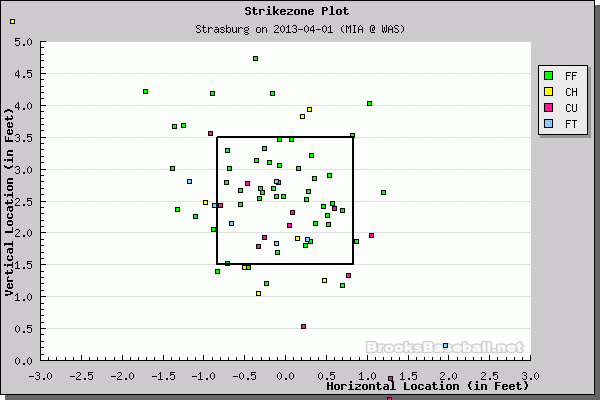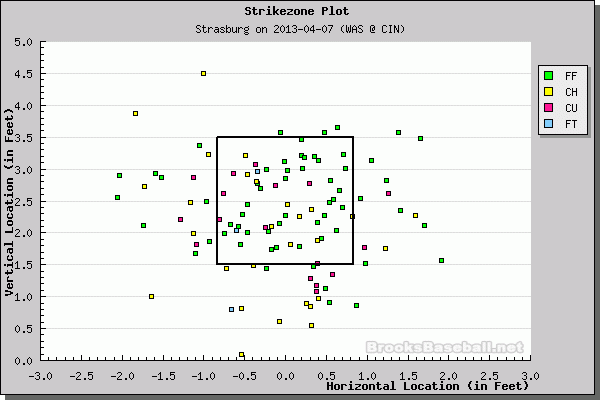I see Brooks Baseball come up enough in my Twitter feed that I have known what it is for a while – a repository for PitchFX information. That is a gross simplification of the work that they do there, but the point is, its the place to be when you want to analyze how the baseball traveled from the pitcher’s release point to the contact with the catcher’s glove, the bat, or the backstop as the case may be.
After Strasburg‘s poor start on Sunday, I finally decided to enter the clandestine world of PitchFX myself, and see what I could find. I looked at both his PitchFX data from the game on Sunday, and Strasburg’s player card, where I examined his 2012 only pitch data. I mentioned this earlier in the week, but the first thing I examined was his fastball velocity. Here is what I said, and this data, of course, hasn’t changed
In 2012, his 4-seam fastball averaged 96.6 mph, and his sinker averaged 95.74 mph. In Sunday’s game, he averaged 95.8 mph on his 4-seamer and 95.61 on the 2-seam sinker.
So it doesn’t seem like the fastball velocity was an issue. I also looked at the movement charts on the fastball, and they seemed pretty much normal as well. As for the other pitches, there were a few things that actually did jump out at me. I noticed something while looking at the Strikezone plot from Sunday. But first, let’s take a look at what his strike zone chart looked like on Opening Day, when he pitched great. It’s by pitch, and “FF” is his four seam fastball while “FT” is the two seamer/sinker (these charts are from the Brooks Baseball links listed above):
Now take a look at Sunday’s chart, which was a bit suspicious to me:
It’s clear is that he looked “different” in the two games. On Sunday he had more pitches outside of the strike the zone, and while some of his changeups were low, his fastball was really horizontally off, as it were. Those numbers weren’t reflected in the horizontal movement on his fastball, just where it ended up, so it was probably more of a problem locating. That’s what you’re first guess would likely be, but I checked on that movement because since I saw nothing amiss, we can eliminate it as the problem now. So locating the fastball might have been an issue.
Another thing that jumped out at me was his ratio of curve balls to changeups. In 2012, he threw 495 curveballs and 419 changeups, which is a 1.18:1 ratio. On Sunday’s game, he threw 28 changeups to only 17 curves, a .6:1 ratio. So why did he do this? And is this common?
Uh, I don’t know, that’s why I’m asking.
I asked Harry Pavlidis, who writes for Baseball Prospectus and is a PitchFX expert, in his BP chat today. Here’s how that went:
NatsReview (Bethesda, MD): I noticed after looking at his start on Brooks, that Strasburg threw 17 curves in Sunday’s game (where he gave up 6 ER) compared to 28 changeups. This is way off his 50-50 ratio from last season. Is there anything to read into this (like he wasn’t comfortable with the curve), or are these variations common game to game?
Harry Pavlidis: He threw an unusually high number of changes in that game. There is a lot of variance game to game but he is usually more curves than changes. Here’s a list of every game he’s pitched, in order, with the total number of changes minus the total number of curves (so negative #s are the odd games where he threw more changes than curves)
14
9
-5
0
-17
6
18
24
22
22
5
-1
1
-5
-3
3
5
12
-8
13
14
26
2
6
-10
-5
-3
-10
3
-3
-8
5
-2
1
-1
4
5
6
3
1
0
14
3
0
6
5
-11
First, the game to game variance isn’t crazy, according to him. Second, that’s alot of numbers, but they aren’t exactly complex numbers. Let’s just take a look at how many games he has where he throws more curves than changeups. I took a look at all 47 games that Harry listed, then I looked at the last 30, which is how many games he’s thrown since the start of 2012.
I put the ratios in there because the numbers can be a little deceptive at first glance. In broad general terms, he throws more curveballs than changes in almost 2/3 of his games, or in twice as many outings. So what he did on Sunday isn’t the norm, but it isn’t exceedingly rare either.
But since almost twice as many games feature the curveball more, perhaps he didn’t have a good feel for that pitch on Sunday? Well, thanks again to PitchFX, one other piece of statistical information jumped out at me. The movement on his curveball was quite different on Sunday than normal. Take a look at the numbers (listed in inches) of the break on his curveball. I only show the curveball here because his 3 other pitches didn’t have a big difference, and I’m not interested in building a three dimensional chart:
 That is interesting, I think. On Sunday, his curveball was breaking an inch and a half more horizontally than usual, and a half an inch extra vertically. Could this be because he didn’t have a very good feel for it? The numbers on Opening Day were much closer to the average, at least on the horizontal side (the vertical break was, in fact, slightly higher). An inch or two, as you know, is the difference between a ball and a strike, or a well hit ball and a dribbler to the infielders. So maybe that is part of the problem.
That is interesting, I think. On Sunday, his curveball was breaking an inch and a half more horizontally than usual, and a half an inch extra vertically. Could this be because he didn’t have a very good feel for it? The numbers on Opening Day were much closer to the average, at least on the horizontal side (the vertical break was, in fact, slightly higher). An inch or two, as you know, is the difference between a ball and a strike, or a well hit ball and a dribbler to the infielders. So maybe that is part of the problem.
[button url=’#’ size=’small’ style=’blue’] So All of This Means… [/button]
I’m new to PitchFX and Brooks, and I don’t have any sweeping conclusions to what was wrong with Strasburg on Sunday. But if I were to tell you that it looked like he had trouble locating his fastball and didn’t have a great feel for his curve, so he overused his changeup – would you disagree?
If that is what happened, well, that will happen from time to time. With more experience, you’d think he would be able to handle those games better, giving up 2 or 3 runs instead of the 6 ER he did.
As for all the data above, it allows us to look for a few things in his next start – specifically with fastball location and curve/change usage. If the changeup usage increases and he’s effective, well, maybe he likes it more. If it does but he’s not effective, we can call McCatty together.




